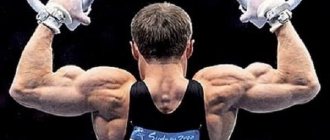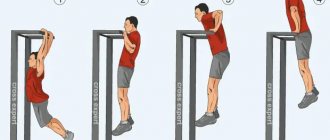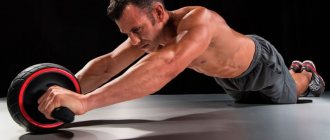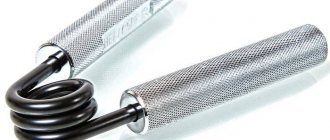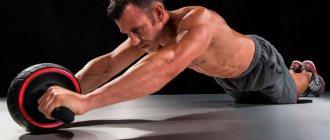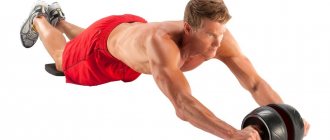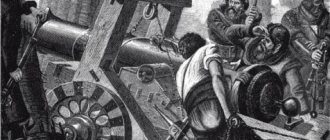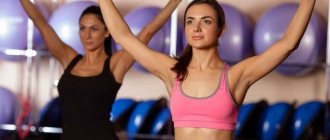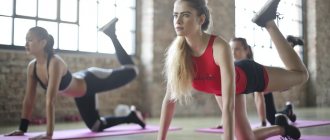What are gymnastic rings?
Rings are an apparatus in the men's artistic gymnastics competition program. It is presented in the form of two rings suspended using special cables.
In accordance with the international rules of gymnastics, the correct location of the projectile suspension point is 5.75 m above the floor, the rings are at a height of 2.75 m. The distance between the rings from each other at rest should be 50 cm. The diameter inside is 18 cm.
Exercises performed on the apparatus are lifts, stops, revolutions and twists. Elements consist of static and dynamic. The performance ends with an acrobatic dismount. Gymnasts are required to have great physical strength. Some static exercises are more difficult in terms of strength compared to dynamic ones.
A static element held for two seconds is counted. The most famous and difficult of them:
- “Cross” is an element during which the athlete hangs motionless with his arms outstretched horizontally.
- “Airplane” is a support that involves spreading your arms and keeping your body in the same plane with the rings.
- “Reverse plane” is a balance exercise: the body is positioned in a plane with rings, arms are spread out, and the back is turned to the floor.
The judges evaluate the degree of difficulty and cleanliness of each element, as well as how well the dismount is performed.
Swinging and swinging exercises
Swinging is an integral part of all compound swing exercises. The gymnast is required to perform precise coordinated actions. The slightest inaccuracy in the athlete’s actions leads to failure to complete the exercise as a whole.
Swinging while hanging
- Performed by successive swings of the body and legs.
- When swinging forward, the rings actively move backwards, and when swinging backwards, they move forward.
- When swinging, the GCM of the body is always located on the vertical, passing through the points of attachment of the rings.
- During the forward swing, at the moment the body passes the vertical, an energetic throwing movement is made with the legs and torso forward and upward, the GCM rises to the greatest possible height, and at the end point of the forward swing, the rings are retracted as far back as possible behind the head.
- From this position, the back swing begins with the back and pelvis, with some lag of the legs.
- When passing the vertical, the legs catch up with the body and are pulled back with an energetic throwing movement, overtaking the body, the GCM of the gymnast’s body reaches its highest point, straight arms are extended forward and actively press on the rings. Then the forward swing begins.
- Active back and forth movements of the arms provide constant tension on the rings, necessary for effective swinging.
Twist forward from a bent hang
- Performed only with a backward swing.
- After the body passes the vertical, a whipping movement is immediately made with the legs back and up.
- Hands gradually spread to the sides, press on the rings and turn outward.
- The shoulders move forward, the head is pulled back.
- At the end of the swing, when the GCM is above the horizontal, a twist is made in the shoulder joints.
- The exercise ends with a hanging bend and arch.
Additional inventory
Training requires special gloves that ensure a secure hold of the rings and prevent injury to the skin of the hands due to friction. Gloves are not required if the apparatus is used for the purpose of general physical development, including the development of muscles and flexibility. A soft mat with a significant area is also required. It spreads under the apparatus and is necessary to prevent the gymnast from getting injured when falling. In addition, the mat reduces the stress on the joints during a dismount.
Rating of the best gymnastic rings for 2022
Plastic
Live UP
A universal product from a Ukrainian manufacturer. The popularity of the models lies in the possibility of their use both in outdoor areas and in indoor halls. The material used is impact-resistant ABS plastic, which can withstand significant temperature changes and bad weather. Suitable for training professional athletes and for fitness.
Main characteristics:
- internal diameter – 180 mm;
- cross section – 28 mm;
- full compliance with Olympic standards.
The projectile is sold with spring locks and nylon hangers.
The average price is 1,790 rubles.
gymnastic rings Live UP
Advantages:
- standard sizes;
- high-strength plastic;
- Nice colour;
- durable locks and straps;
- inexpensive.
Flaws:
- uncomfortable for people with wide palms.
WALLBARZ
The universal simulator is very suitable for training on the wall bars, adding variety to them. It can be used by people whose weight does not exceed 100 kg. The product weighs only 1.5 kg and is 160 cm long. Plastic rings are attached to a cotton cord.
Price – 1399 rubles.
gymnastic rings WALLBARZ
Advantages:
- reliability;
- strength;
- quality of workmanship.
Flaws:
- short service life.
CrossFit Indigo 97654 IR B
High-quality products from a Russian manufacturer are produced in full compliance with the requirements of the Olympic Committee. It is used by both professional athletes and those who simply want to regularly maintain their physical fitness at the proper level. Withstands loads up to 90 kg. The set includes nylon hangers and spring locks.
The average cost is 2600 rubles.
gymnastic rings Crossfit Indigo 97654 IR B
Advantages:
- made of durable high quality material;
- with reinforced 6-meter slings;
- suitable for outdoor areas;
- with quality locks.
Flaws:
- no significant ones were found.
WORKOUT K1 (28 mm)
Perfect for both gyms and home use. In the production of equipment, impact-resistant ABS plastic is used, which is resistant to rain, snow, severe frosts, and the scorching sun. It is in demand among both professionals and amateurs. Gives you the opportunity to perform a variety of strength exercises that promote the development of the abdominal muscles, arms, back, and chest. Outperforms other projectiles. Constant mobility forces the trainee to use additional resources to keep the body in balance, while almost all the muscles of the body are involved in the work.
Main characteristics:
- load (max.) – 350 kg;
- internal diameter – 182 mm;
- outer diameter – 238 mm;
- black color;
- weight – 900 g.
Price – 3000 rubles.
gymnastic rings WORKOUT K1 (28 mm)
Advantages:
- made of durable material;
- used by both professionals and amateurs;
- sizes match Olympic standards;
- acceptable cost.
Flaws:
- The kit does not include suspension straps.
UFC Ultimate Training
The owner of the best reviews according to numerous buyers. The best American manufacturer of this type of product constantly introduces its fans to new products. Standard size product: internal diameter – 180 mm, external – 22.5 mm. Material of manufacture: ABS plastic. The package includes reinforced nylon straps, which are 5000 mm long and 30.8 mm wide.
Price – 3390 rubles.
gymnastic rings UFC Ultimate Training
Advantages:
- reliability;
- quality;
- comfort;
- efficiency.
Flaws:
- the grip is not big enough.
MIDZUMI (2 in 1)
The plastic model allows you to significantly expand the capabilities of the complex. You can hang from it by your arms and legs. It can be used as an additional support for climbing to the top of the sports complex. It is an integral part of many modern sports complexes. Description of the package:
- cord – 2 pcs.;
- ring – 2 pcs.;
- clamp – 2 pcs.;
- coil – 2 pcs.
The average price is 420 rubles.
gymnastic rings MIDZUMI (2 in 1)
Advantages:
- high quality material;
- original design;
- maximum permissible load – 100 kg;
- long service life - 5 years;
- acceptable cost.
Flaws:
- small internal diameter (106 mm).
Wooden
ZSO, PROF
An excellent product for gymnastics. High quality plywood is used in production. The thickness of the rings is 35 mm, the outer diameter is 235 mm, the suspension length is 3000 mm, the slings are nylon, the cable is steel with PVC braid. The total weight is one and a half kilograms.
Price – 3192 rubles.
gymnastic rings ZSO, PROF
Advantages:
- comfortable;
- practical;
- quality;
- reliable.
Flaws:
- no significant ones were identified.
WORKOUT K3 (30 mm) TRENER
If lovers of physical activity are wondering which company is better to choose a product, then you should pay special attention to this brand. The projectile has special thickenings that allow you to make a deep grip, increasing the area of support for your hands, making it easier to perform exercises. The simulator makes it possible to gradually increase the load and complicate the tasks. Made of high-quality material, equipped with a special system for attaching carabiners. You can hang it both in the hall and at home.
Price – 3000 rubles.
gymnastic rings WORKOUT K3 (30 mm) TRENER
Advantages:
- reliable;
- durable;
- comfortable;
- maximum load – 350 kg;
- multifunctional.
Flaws:
- no significant ones.
Proxima PGR-2403WD
Wooden rings with an internal diameter of 240 mm, attached to five-meter steel slings. The product is deservedly popular among both professional gymnasts and amateurs. Well pumps up the muscles of the back, arms, chest. Meets all selection criteria. Where can I buy it? At a specialized point for selling sports equipment or order online in an online store, having previously studied a review of suitable products and read the opinions of customers.
How much does it cost - 1490 rubles.
gymnastic rings Proxima PGR-2403WD
Advantages:
- durability;
- functionality;
- reliability;
- long service life.
Flaws:
- no significant ones were found.
WORKOUT K3 (32 mm) SKALOLAZ
How to choose a model for fans of rock climbing and mountaineering? Pay attention to the products of this manufacturer. It is available with an additional function - special indentations of various types, which allows you to develop the tenacity of your fingers. The rings can be used for both hanging and fingertip strengthening, allowing you to simulate mountain climbing training without leaving your home.
Cost – 4100 rubles.
gymnastic rings WORKOUT K3 (32 mm) SKALOLAZ
Advantages:
- can withstand a maximum load of 350 kg;
- reliable;
- durable;
- multifunctional;
- comfortable;
- good quality.
Flaws:
- significant ones have not been established.
PROTRAIN RS1002
Wooden products from a Chinese manufacturer are in great demand among those who do crossfit, perform strength exercises, and try to strengthen all muscle groups, not trusting barbells and dumbbells. Can be used both at home and in the gym. If you choose this model, you will be able to avoid mistakes when choosing.
Price – 6650 rubles.
gymnastic rings PROTRAIN RS1002
Advantages:
- durable;
- comfortable;
- functional;
- quality;
- durable.
Flaws:
- significant cost.
WORKOUT K2 (PRO 28mm)
If the question arises, which is the best projectile to buy, then it is worth considering this model. A distinctive feature is the presence of reinforced slings equipped with spring locks. Widely used both in the hall and at home. In production, high-quality multi-layer plywood with a varnish coating is used. The product fully complies with the requirements established for artistic gymnastics. Can be used by both professionals and beginners.
Price – 3300 rubles.
gymnastic rings WORKOUT K2 (PRO 28mm)
Advantages:
- the ability to adjust the height of the slings;
- Almost all muscles are involved in the work;
- a maximum load of 350 kg is allowed;
- durable;
- effective.
Flaws:
- none.
Children's
Alpinistik
Additional equipment for children's sports grounds. Perfectly develops the baby's physical skills, helping him grow strong and resilient. Designed for weight up to 35 kg. Produced by a Russian company, it has excellent quality and reliability.
Price – 499 rubles.
gymnastic rings Alpinistik
Advantages:
- made of high quality material;
- reliable;
- durable;
- convenient.
Flaws:
- none.
WALLBARZ
The kids really love to train on this apparatus. It not only lifts your mood, but also increases endurance, strengthens muscles and vestibular apparatus, pumps up your abs, arms, and back. The plastic rings have nicks and irregularities that allow little ones to cling to them tightly. They are suspended on a cord of 10 mm diameter. The product fully complies with established GOST standards. The maximum permissible load is 50 kg. It is recommended for children over three years of age.
Cost – 599 rubles.
gymnastic rings WALLBARZ
Advantages:
- safe;
- comfortable;
- durable;
- effective.
Flaws:
- not identified.
PERFETTO SPORT Mickey PS-311
The bright red colored equipment is perfect for kids who have been interested in gymnastics since childhood and want to be strong and healthy. It is an additional equipment for the sports complex. Used by boys and girls who have reached the age of three, weighing no more than 50 kg. Can be hung both outdoors and at home.
Price – 615 rubles.
gymnastic rings PERFETTO SPORT Mickey PS-311
Advantages:
- colorful;
- comfortable;
- practical;
- multifunctional;
- excellent combination of price and quality.
Flaws:
- not defined.
ROMANA DSK-VO 91.03.10-21
A fun and very useful children's simulator. You can use it to do pull-ups, swing, do push-ups, and hang from both your arms and legs. It trains muscles, strengthens the vestibular apparatus, and pumps up the abs. The rings are made of high-quality plastic, environmentally friendly and non-allergenic. The presence of jags and irregularities allows you to avoid traumatic situations. During production, the manufacturer adheres to all GOST requirements, especially with regard to fastenings and strength of cables, as well as clamps.
The average price is 470 rubles.
gymnastic rings ROMANA DSK-VO 91.03.10-21
Advantages:
- reliability;
- durability;
- practicality;
- maximum permissible weight – 50 kg;
- high quality workmanship material.
Flaws:
- none.
WB KIDS
The product is produced in Russia for children from 2 to 9 years old. It is intended for games and exercises, develops muscles due to the presence of static and dynamic loads. Can be mounted both in gyms and outdoors (to trees), as well as at home.
Cost – 2175 rubles.
gymnastic rings WB KIDS
Advantages:
- not traumatic;
- simple;
- reliable;
- beautiful;
- durable.
Flaws:
- completely absent.
KAMPFER F0000014377
An excellent trainer for the younger generation. It is designed for teenagers whose weight reaches 100 kg. Made from high quality plastic. The package includes a reel, cord and clamp. Product weight – 1 kg. Can be used both at home and outdoors.
Price – 420 rubles.
gymnastic rings KAMPFER F0000014377
Advantages:
- very convenient;
- quite reliable;
- fulfilled taking into account all legally established requirements;
- excellent value for money.
Flaws:
- no significant ones.
Materials for making a projectile
The most common types are wooden, plastic and metal rings. They differ in properties and cost.
The wooden apparatus is pleasant to touch, but there are restrictions regarding the weight of the athlete. Such rings can withstand up to 80 kg. It is necessary to take into account the fact that the loads during jerks increase significantly. Wooden rings are suitable for children and are also suitable for simple exercises without jerking.
If the choice fell on a wooden projectile, then you should purchase products from well-known brands. Conscientious manufacturers use high quality wood and test the rings for tensile strength by subjecting them to a large mass.
Plastic rings are the most popular. Their surface often has convex lines or dots. They provide a strong grip on the projectile, as they prevent hands from slipping. Compared to wood, plastic is more uniform. In this regard, rupture of such rings during normal use within the permissible load is impossible. Professional athletes do not use a projectile that has a relief, because it creates difficulties when intercepting the ring.
Metal shells are the strongest and heaviest. They have a thick layer of rubber coating that prevents palms from slipping. Typically used by weightlifters developing endurance. Metal rings are purchased for workout classes. The body weight of athletes in this discipline often exceeds 100 kg.
As for cable materials, the more elastic it is, the easier it is to perform dynamic exercises. It pulls the athlete up, throws him up and thereby reduces the load on the muscles. During competitions, professional gymnasts use a steel cable whose elasticity is zero. The athlete’s contact with the cable is eliminated due to the rigid textile belt. It connects the cable to the rings. An amateur projectile is suspended on a cord.
How to make a mini sports complex for a child yourself
All parents dream of seeing their child healthy and happy and for this they spare no effort or money. You can, of course, choose products from the best manufacturers by first studying the ratings of quality exercise equipment. But they are usually too expensive in price and equipped with additional functionality that is unacceptable to you.
It is worth noting that the best things are made with your own hands. If you want to do good for your child and have enough free time, then you can set up a small gym right at home. It will take only 2 - 3 sq.m. free space and will bring a lot of pleasure to the baby, and will also bring him great benefits.
Positive aspects of having such a home sports corner:
- Active development of the child at any time convenient for him.
- A fun time.
- Preparing the body for future physical activity at school.
- Classes together with relatives.
- Development of the vestibular apparatus.
- Improving the functioning of the cardiovascular system.
- Development of correct coordination of movements.
To avoid injuring your daughter or son during classes, you need to take care of a high-quality mat. Main elements of the mini-complex:
- Swedish wall;
- gymnastic rings;
- low horizontal bar or parallel bars;
- hanging rope ladder;
- soft flooring.
Let's focus on making gymnastic rings with our own hands.
Step-by-step instruction
Required tools and materials:
- construction compass;
- plywood sheet measuring 75 by 75 cm, two pieces;
- bolts or press;
- wood glue;
- milling machine;
- rafters;
- jigsaw;
- screwdriver
Procedure:
- We draw both sheets of plywood into 6 identical squares and cut them out using a jigsaw.
- We take two squares and glue them together using wood glue. This makes two plywood sandwiches.
- In order for the structure to dry properly, it must be placed under a press for several days or tightened in the center and corners with bolts.
- In order to tighten the plywood blanks as much as possible, it is necessary to use screws or bolts for this purpose.
- After complete drying, you need to draw circles with an internal diameter of 180 mm on plywood blanks. The outer edge will be 205mm.
- Cut out the products carefully using a jigsaw.
- The structure must be given a circular cross-section. This can be done using a milling machine.
- Afterwards they are sanded and varnished.
- We take one side of the horizontal bar and use a drill to make holes in it at a distance of 40 cm.
- We pass the rafters through them and attach them at the required height. It is best to buy rafters in a specialized store. They must be reliable and durable, since the entire load falls on them. If your financial situation does not allow you to purchase an expensive product, then you can take a strong rope.
Ring program structure
Group 1 includes twists, large and double turns, and various lifts. Lifting allows the athlete to change position (hanging on the emphasis).
Group 2 included lifts through a backswing and a flip into a stance, as well as high revolutions.
Group 3 is a complex of complex flywheel elements, consisting of a high angle, a cross and horizontal stops.
Group 4 is a set of all static elements: corners, crosses, horizontal stops and hangers. This includes a complex of power lifting and lowering.
A dismount, representing a vertical somersault, completes the performance.
Gymnastics at the Olympics
Artistic gymnastics is invariably included in the program of the Olympic Games, occupying one of the central places in it.
True, the gymnastics program of the very first Modern Games (1896) was somewhat different from the current Olympics. 18 gymnasts, representing 5 countries in Athens, competed in individual all-around events: not only in the usual exercises (with the exception of floor), but also in group exercises on parallel bars and horizontal bar and in rope climbing. The dominance of the founders of gymnastics - the Germans - in all types of programs was almost undivided.
The first absolute champion of the Olympic Games in artistic gymnastics was the Frenchman Gustave Sandra in 1900. The championship among teams and in individual all-around events was not competed for at the Paris Olympics.
At the 1904 Games, another unusual discipline appeared in the competition program among gymnasts: exercises with clubs. As you know, the overwhelming majority of participants in the St. Louis Olympics represented the United States. So the unconditional success of the Americans on the gymnastics platform was quite predictable.
At the next two Olympics there was no equal to the Italian Alberto Braglia. At the 1912 Games, he also added gold to his title of absolute champion, won as part of the Italian team in the team competition.
Competitions in certain types of all-around gymnastics reappeared in the Olympic program after the First World War - at the 1924 Games.
Four years later, women competed in the Olympic gymnastics tournament for the first time. True, the gymnasts again missed the next Olympics - and only in 1936 they began to participate in them constantly. It is noteworthy that the program of the 1936 Olympic tournament in women's gymnastics also included exercises on parallel bars. And at the 1948 Olympics, women performed mandatory ring exercises. At one time, the program of the Olympic tournament in women's gymnastics also included group exercises with various objects (mace, ball, etc.), which later became an integral part of rhythmic gymnastics. At the 1952 Games, a significant change was made to the competition formula in women's gymnastics: for the first time, athletes competed in the individual competition (on four apparatus). In its current form, the Olympic program for women's gymnastics was finally determined in 1960 (Men have competed for awards according to the 6+1+1 scheme since 1936).
In the team competition in the history of Olympic gymnastics tournaments, there was and is no equal to the USSR women's team, which has risen to the highest step of the podium 10 times. Among men, the teams of the USSR and Japan won more often than others - 5 times each. The Italian men's team celebrated victory four times - although this was before the Second World War.
The title of absolute Olympic champion is considered the highest title in artistic gymnastics. The outstanding Soviet gymnast Larisa Latynina achieved a unique achievement. Her collection includes 18 Olympic medals (of which 9 are gold: 6 received in individual and 3 in team competitions). None of the Olympians have yet managed to repeat, or even surpass, this record. Czech gymnast Vera Caslavska (Odlozhikova) won 7 gold medals (all in the individual competition). The same amount of “gold” (as well as 5 silver and 3 bronze medals) in Nikolai Andrianov’s collection of awards. (Andrianov and Latynina are the two most titled athletes in the history of world gymnastics.) Another of our gymnasts, Alexander Dityatin, set another unique record at the 1980 Olympics, winning 8 out of 8 possible awards: in the team event, in the “absolute” and in individual all-around events (3 gold, 4 silver and 1 bronze medals).
Vitaly Shcherbo completed the “Soviet era” in Olympic gymnastics with dignity: performing at the 1992 Games as part of the united team of the CIS countries, he won 6 gold medals.
Lessons for beginners
Beginners can use professional equipment, as well as homemade ones. The rings are attached to ropes. You can hang the apparatus on a horizontal bar, a gymnastics wall, or even on a tree. Exercises are allowed not only at home and in the gym, but also in the fresh air.
Elementary exercises are suitable for beginner gymnasts:
- Push-ups are the same as on the floor, only with rings in your hands (they need to be lowered to the floor). This is difficult, so first you can raise the projectile to your waist. Then the load is increased by raising the legs above the level of the arms. The duration of the “plank” - emphasis without movement - is increased to three minutes. Care must be taken as the heart muscle is stressed.
- The pull-up on the rings is similar to the pull-up on the bar. You need to hold the rings without moving. The legs are on the floor, the body is kept straight and motionless, trying to touch the projectile with the chest.
- Raising your legs while hanging builds your abs. First, the limbs are raised with bent knees, then straight.
The cross is a very difficult exercise, it is performed by professionals. But no one forbids beginning gymnasts from trying to master it, because they need to start sometime. This static element is also called the “Azaryan cross” - hanging with arms that are located at an angle of 90⁰ to the body. The cross serves as a link to many other elements.
Raising and lowering by force
The exercise begins with low rings and a deep grip, which places the gymnast's wrist in the optimal position to provide a "turnover" or "transition."
Raising and lowering by force is performed from:
- hanging by force, bending over through bent and straight arms;
- hanging from behind by force, hanging bent over;
- hanging bent, lowering back, hanging from behind and dismounting;
- hanging, bending over, lowering back, hanging from behind and dismounting;
- emphasis lowering forward and backward into a bent-over position;
- lifting with force at point-blank range.
Forward swing lift
- Performed from swinging while hanging.
- At the end point of the backward swing, the body's central mass moves as far as possible from the support, creating the greatest possible moment of inertia of the body.
- During the forward swing, as the body approaches the vertical, the chest and stomach overtake the legs, and the muscles of the front surface of the body are tense.
- Then, due to their energetic contraction, the legs are sent forward and upward in a whipping motion. They create the greatest moment of momentum.
- Next, leaning on your feet and pressing on the rings with straight arms, a jerking movement is made downwards. Now the torso overtakes the legs and, due to this, moves upward, point-blank.
Backward swing
- Performed from swinging while hanging.
- At the end point of the forward swing, the body's central mass is extremely removed from the support due to the retraction of the rings back behind the head, the straightening of the body with the position of the legs above the rings, the closed position of the chest, the retracted abdomen, the rounded back and the lowered head. In this case, the greatest possible moment of inertia of the body is created.
- On the backswing, moving by inertia, as the body approaches the vertical, the gymnast, actively sagging in the shoulder joints, performs a swing. In this case, the back precedes the movement of the legs.
- Then the legs precede the movement of the body, due to which a powerful throwing movement (whip) is made with the legs back and up, while the hands actively press down on the rings through the sides.
Lifting by force
- Performed from a hanging position with a deep grip on straight arms, hands turned forward and outward.
- Pulling up and slightly bending at the hip joints, the shoulders are pulled back slightly, while the hands are kept closer to each other, the elbows forward.
- By pressing the rings with your hands and turning your hands, your shoulders quickly move forward, your elbows are pulled back, and you come out point-blank with your arms bent.
- Bend over, straightening your arms.
- The lift is performed at the same pace, without stopping.
Forward rotation while bending over from support
- All actions are performed without stopping.
- The arms slowly bend.
- Shoulders drop forward and down.
- Without lifting the pelvis up, the rings are turned outward and slowly lowered into a hanging position, bent over bent arms in a deep grip.
- Continuing to turn the hands, the shoulders move forward and, without straightening the hip joints, a force lift is performed.
From an angle support, lowering forward into a bent-over position
- The arms slowly bend.
- Shoulders drop forward and down.
- The arms are extended.
- The rings are turned outward.
- Without lifting the pelvis up, slowly lower it into a bent position.
- During lowering, the rings are pressed against the pelvis.
- The exercise is performed at a slow pace without jerking.
Training program for beginners
Graduation of athletes by age
In the Russian Federation, the following age groups participate in competitions:
- men – (from eighteen years and older);
- juniors (sixteen to seventeen years old);
- juniors (fourteen to seventeen years old);
- juniors (fourteen to fifteen years old);
- boys (twelve to thirteen years old);
- boys (eleven years old);
- boys (ten years old);
- boys (nine years old);
- boys (eight years old);
- boys (seven years old).
The requirements for the elements performed by gymnasts vary depending on the athlete’s weight group.
The origin and development of modern artistic gymnastics
In the XVIII - early XIX centuries. In Germany, a physical education system was being formed, which was based on gymnastics. The founder of the German gymnastics movement was F.L. Jan. He significantly expanded the “gymnastic field” and invented new exercises and apparatus (including the horizontal bar and parallel bars), thereby laying the foundations of modern artistic gymnastics. In 1811, Jan opened the first gymnastics ground (near Berlin), and five years later he published - together with one of his students E. Eiselen - the book German Gymnastics
: it contained descriptions of the basic exercises and the necessary methodological recommendations. The first public performances of gymnasts date back to approximately this time.
Their own systems of physical education were developed in the Czech Republic, Sweden and France, and a little later – in Russia. During this period, exercises on apparatus and vaults were cultivated. Although floor exercises in one form or another were known several centuries ago (for example, from the performances of traveling circus troupes, which demonstrated, among other things, unusual acts on the floor or on the ground), they did not immediately gain recognition as one of the gymnastic disciplines.
In its development, artistic gymnastics went through several stages: over time, the requirements for it and, accordingly, its content changed. History of gymnastics in the 19th century. was largely determined by the confrontation between two fundamentally different systems: the Swedish, in which the emphasis was primarily on floor exercises (in a broad sense), and the German, which gravitated towards apparatus exercises.
In the middle of the century, the first indoor gymnasiums appeared in Germany (before that, only open areas operated). Official competitions in artistic gymnastics begin. In the second half of the 19th century. Europe, and later America, are experiencing a real gymnastics boom.
And the next century can rightfully be called the “century of gymnastics.” Although the modern program of gymnastic competitions was not immediately determined. Moreover, they took place in an unusual way. Gymnast competitions were often held outdoors. At first, there were no uniform technical requirements for gymnastic equipment: often national teams came to international competitions with their own “props”.
Before World War II, gymnasts from Germany, Czechoslovakia, France, Italy, Switzerland, Finland, the USA, Yugoslavia, and Hungary performed more successfully than others. In the 50s, the world gymnastic elite included athletes from the USSR and Japan, later from Romania, China and Bulgaria, and with the collapse of the USSR - representatives from Russia, Ukraine and Belarus.
Composition of the panel of judges
The panel includes: the main panel of judges (GCJ), judges of teams D and E, timekeeper judge, judge responsible for the musical part, informing judge, secretaries. GSK creates an organization that conducts competitions.
The competition is managed by the GSK. It must include the following: the chief judge, the chief secretary and their deputies. Membership of athletes and coaches is not permitted.
Responsibilities of the chief judge:
- organization and preparation of competitions;
- consideration of applications to increase the height of the rings;
- holding an organizational meeting;
- provision of information data;
- ensuring a press conference;
- checking the organization of medical care;
- presentation of a report from the organization that held the competition.
Rights:
- allowing the gymnast to try again if the performance was hindered by a malfunction of the equipment or equipment, or if there was another reason beyond the control of the participant;
- punishment and removal of judges in exceptional cases (obvious judicial error);
- suspension and termination of competitions if their normal holding is impossible;
- removal from competitions of gymnasts, judges and coaches if they commit immoral acts;
- removal of unprepared participants.
The chief judge is also a member of the appeal jury, which is responsible for considering protests against the actions of the GSJ and teams of judges and making decisions on disciplinary punishment.
Some other rules
Gymnastics is one of those sports that has undergone an intensive process of “rejuvenation” in recent decades. A kind of record was set in 1987 by the Romanian gymnast Aurelia Dobre, who won the title of absolute world champion at the age of less than 15. Even younger was her compatriot Daniela Silivas, who two years earlier received a gold medal at the World Championships for winning the balance beam exercise. Currently, the minimum age for participants in major international gymnastics tournaments is not 15, as before, but 16 years old (the same age athletes must turn in the year of the competition).
There are also some “procedural” restrictions in modern artistic gymnastics:
– the transition from projectile to projectile is carried out in an organized manner;
– competition participants are given 30–40 seconds to warm up, after which they are called to perform the exercise;
– during the execution of the program, the coach has no right to talk to the gymnast;
– during the competition, participants do not have the right to leave the site without special permission.
The rules provide for penalties for individual gymnasts and entire teams: for example, for failure to appear for warm-ups. Unsportsmanlike (and undisciplined) behavior of athletes is punishable by a fine.
Failure to comply with the dress code can also affect the results of a gymnast’s performance. The first remark entails a deduction of points – and up to and including removal from the competition in the overall classification.
When performing exercises on apparatus, it is allowed to use special leather pads for the palms to avoid damage.
Grading system
The actions of the gymnasts during the performance are evaluated by the judges. In this case, the accuracy and correctness of all elements are taken into account; the assessment depends on these factors.
- The program runs without errors, the structure of the elements is not violated. Correct posture, large range of movements, their clarity, ease.
- Compliance of the content of the mandatory exercise with its description. Free tricks satisfy the requirements regarding composition and degree of difficulty.
- The beginning of the performance is the main stance that the gymnast takes in front of the apparatus, also in the case when assistants provide assistance.
- The end of the execution is the moment when the athlete lands and takes the main stance.
- For deviations from perfect execution and failure to comply with instructions regarding the content of the exercise, deductions are assigned.
- Large deductions are made for what is the main thing in a given element and determines its difficulty.
- In the performance, sometimes minor blemishes are allowed (in posture, insufficient lightness and expressiveness). Due to their small size, deductions are given for the totality of such errors.
- Evaluation occurs with an accuracy of 0.1 points.
While performing, a gymnast can make different types of mistakes. A minor error is an insignificant deviation from perfect execution, the deduction is 0.1 point. An average error is a significant deviation from ideal execution; the deduction will be 0.3 points. A gross error is a major distortion, including one bordering on non-compliance, the size of the deduction is 0.5-1.0 points. Error of non-execution - a change in a component of an exercise that resulted in the execution of another element, or a very large distortion.
Evaluation is carried out openly and the final grade is announced. The athlete is given one attempt to perform. If the gymnast was hampered by the faulty condition of the apparatus or there were other reasons beyond his control that led to improper performance, then he, having received the permission of the chief judge, has the right to repeat the attempt after a rest break.
Gymnastics all-around
All-around combines all disciplines of artistic gymnastics. Therefore, the all-around competition is also called the absolute championship, and the winner is the absolute champion.
Men's championship
The men's all-around includes 6 disciplines: competitions on the pommel horse, rings, uneven bars, horizontal bar, as well as floor exercises on the mat and vault. At the Olympic Games, competitions are held between teams and in individual competitions.
Team all-around
Until 2016, inclusive, the team consisted of 5 athletes. In 2021, the gymnast team was reduced to 4 people.
Qualification. At the qualification stage, each team can have 3 or 4 athletes perform on each apparatus. At the end of qualifying, the results of the three best athletes are selected. All points earned are summed up and the finalists are determined – eight teams.
The team all-around final is held one day after qualification. All points scored during the preliminary stage will be cancelled.
The final. There are 4 gymnasts on the team. On each apparatus, 3 gymnasts perform from each team (at the discretion of the coach). For example, one gymnast can perform on the pommel horse, but on the horizontal bar, one gymnast is replaced by another.
Thus, in the team all-around, 18 exercises are performed - 3 exercises each on 6 apparatus: pommel horse, rings, uneven bars, horizontal bar, vault, carpet. All points earned are summed up and the winning teams are determined.
Personal all-around
The individual all-around final is held two days later. All gymnasts take turns performing the exercise on one apparatus, then move on to another. For each exercise, earned points are awarded. Then the total score for six exercises is summed up and the absolute champion in artistic gymnastics is declared.
Women's program
The rules of the competition coincide with the men's regulations. The women's all-around sports program consists of 4 gymnastic exercises: beam, uneven bars, floor exercise, vault.
Federation
Listed below are the largest global and domestic organizations that oversee the development of gymnastics.
- The International Gymnastics Federation (FIG) is the oldest international sports federation. It was founded in 1881. It is engaged in the development of regulations for speeches, which determine the rules of evaluation.
- The European Gymnastics Union (UEG) unites the national gymnastics federations of European countries. Founded 1982
- The Russian Artistic Gymnastics Federation is a public organization that represents the interests of gymnastics disciplines. Established in 1991. It unites sports organizations of 71 constituent entities of the Russian Federation.
Gymnastics in antiquity and the Middle Ages
Gymnastics as a sport and an integral system of physical education originated in Ancient Greece. Homer, Aristotle and Plato wrote and spoke about the beneficial effects of regular gymnastics on the harmonious development of the individual. In addition to the general developmental and special exercises that are familiar to us, the gymnastics of the ancient Greeks included swimming, running, wrestling, boxing, riding (horseback and chariot riding), etc. According to one version, the word “gymnastics” itself comes from the Greek “gumnos” (naked): as you know, ancient Greek athletes competed without clothes.
Early Christians considered gymnastics a “satanic invention,” opposing the carnal, i.e. its “sinful” beginning - which, first of all, meant the nakedness of athletes - - spiritual, sublime. In 393, gymnastics was officially banned.
In ancient times, not only the Greeks were familiar with gymnastics. For example, in China and India several thousand years ago, gymnastic exercises were also practiced - mainly for medicinal purposes. Even then, special devices were known, similar to some modern gymnastic apparatus. Thus, in ancient Rome, to teach the basics of horse riding, a certain semblance of the “horse” known to us was used.
With the beginning of the European Renaissance, interest in gymnastics of the ancient Greeks reawakened: Renaissance thinkers perceived it as a means of strengthening health and general physical development of a person. The theoretical foundations of the physical education system are gradually being laid (Rousseau, Pestalozzi, etc.). The immediate predecessor of modern artistic gymnastics in the 16th–17th centuries. Vaulting (exercises and jumps) on a table and a horse, climbing a pole and a wall, maintaining balance on a rope and trees became very popular at that time.
The evolution of ring gymnastics
The rings gymnastics program includes two parts: strength and swing. In different years, one of them, then the other, prevailed. In this discipline, development proceeds in a spiral manner.
1930-50s
In ring gymnastics of the 30s, the strength part had the advantage; its elements were very complex. The flywheel is characterized by the presence of only twists forward or backward, and the amplitude does not develop. A simple dismount ends the performance. It represents a back somersault, bending over.
The elements of the power unit had to be held for at least three seconds. This fragment of the performance is characterized by the presence of angles, handstands, different revolutions, crosses, etc. In 1936, such a complex element as the “cross” was performed by all athletes without exception, and its execution was of different types. In addition, in those years one could see the implementation of the “reverse cross”, which would gain popularity only 50 years later. Also in the 30s, attempts were made to create an “airplane”.
In the late 50s, almost nothing had changed. Strength exercises still prevailed, but in the fly part attempts began to perform large rotations through bent arms.
The outstanding gymnast of that time was the Soviet athlete Albert Azaryan, three-time Olympic champion, four-time world champion. His program is a model for all athletes in this discipline of the late 50s. He was the first to perform the element “forcibly from the hang, flip back into the cross,” which is still listed in the international regulations under the name “Azaryan.”
1960s
At this time, significant changes occurred in ring gymnastics. The revolution in combinations took place thanks to the talented athlete Mikhail Voronin. He pioneered the use of a new technique for performing large rotations, which made it possible to perform them in such a way that the arms remained straight. The capabilities of the flywheel component have been rethought. In the mid-60s, they stopped performing such power cascades as in the 50s. The attention of athletes turned to high twists and high revolutions. Dismounts have become more difficult.
1970s
The combinations of these years have not undergone major changes. Flying elements developed. In 1976, the Japanese athlete Fukio Honma demonstrated a new product - a forward flip lift, which began to be included in the combinations of all leading gymnasts. Athletes of the 70s carefully practiced dismounts, improving them. At the end of the decade, gymnasts performed the dismount in the form of a double back somersault while bending over.
The development also affected the power part, although each combination consisted of no more than two complex static stops.
1980s
At the beginning of the decade, flywheel elements continued to develop. For example, Yuri Korolev performed a triple backflip into a dismount. This trick had already been demonstrated in the 70s, but then it seemed strange and impossible to perform in the future. Now the triple somersault is performed by many athletes.
An interesting experiment was carried out by Chinese gymnast Li Ning. He transferred elements performed on the crossbar to ring gymnastics. In 1983, each athletes’ program was characterized by the presence of two power elements: a cross and a horizontal support “legs together”. The end of the 80s was marked by an innovation in the flywheel - double forward rotations in a tuck or bent position. Statics has become more complex. The “Azaryan Cross” was very popular.
1990s
For twenty years there was almost no evolution in programs. The development of gymnastics proceeded slowly, small complications were added gradually. In the 90s, serious changes took place. In 1992, the rules changed; athletes were required to predominate in the complex static part. The swing program was again transformed into a strength program.
At the Olympic Games in 1996, gymnasts no longer performed two, but four elements of the power section. The degree of their complexity has also increased. For example, an element such as “airplane” was improved by the Italian athlete Yuri Keki. He performed it flawlessly - all parts of the body formed one straight line.
The swing section of the program at this time was represented only by large revolutions. The dismount was simplified - it was performed in the form of a regular double blanche backwards.
2000-2010
During this period the rules changed again. There are additional points for connecting power elements. Athletes formed their combinations in different ways. The programs contained four or five power elements performed one after another. For example, “Kip-up into an airplane”, “Horizontal hang from behind into a cross”, “Rise into an airplane” and “Azaryan cross”. Other gymnasts combined swing and power lifts in static elements.
2005 – the peak of development of complex combinations of power section elements.
In 2006, the rules changed dramatically. There was no base, but a score for complexity appeared. It increased as the program was filled with the maximum number of difficulties. The combination had to contain ten difficult elements. Requirements for the dismount are not lower than group D. An increase for connecting strength exercises was given if the athlete increased the center of gravity in the next element relative to the previous one. In 2009, the rules were changed again. Increases for connections of power section elements have been removed.
In 2009-2010 the difference in the complexity of the combination between the “siloviki” and the “flywheels” has almost disappeared. These years saw high competition between gymnasts. The technique of performing strength exercises was very high. An example of a combination of these years is the program of the Chinese athlete Yang Mingyong. Its power part consisted of seven complex elements.
2011 – 2022
The results of the 2012 Olympics showed that the complexity of the programs of the world's leading gymnasts was already 6.8-6.9, and its subsequent increase is fraught with problems in the quality of performance. In this regard, athletes began to work more on the purity of performing strength exercises. By 2015, most gymnasts had perfected their dismounts.
Features of exercises on rings
The main distinguishing feature of the gymnastic ring apparatus is its mobility. When the gymnast moves, the apparatus moves in the opposite direction. And in order to keep them in the desired position, the athlete will have to make additional physical efforts.
Combinations on rings include a variety of elements:
- flight feathers;
- strength - lifting and lowering, handstands;
- statistical - hangs, stops.
Combination elements on rings are performed from different starting positions and with different amplitudes. To perform them, the athlete must have developed muscle strength, flexibility (especially of the wrist joint), a sense of space and balance, psychological stability, and no fear.
The benefits of exercising on gymnastic rings
Gymnastic rings are used to train athletes at all stages of sports training, as well as in amateur sports and home training.
A variety of exercises are performed on a gymnastic apparatus - push-ups, pull-ups, squats.
Benefits of exercise:
- While performing exercises on the rings, the motor muscles and stabilizer muscles, which are responsible for maintaining the balance of body parts relative to each other, are worked out, and their strength increases.
- Joint flexibility develops.
- Coordination of movements improves.
- Exercises can be included in a comprehensive posture correction program.
Using rings at home
Gymnastic rings are compact, easy to transport, affordable, and easy to install at home, on sports grounds, and outdoors. You can buy a gymnastic apparatus or make it yourself. The rings are attached using ropes to the horizontal bar or wall bars.
Literature
Several textbooks on gymnastics are worth mentioning, including those on the “Rings” discipline.
- N. G. Suchilin. "Men, rings." One of the best guides to the rings program in artistic men's gymnastics. The book sets out the basics of the theory and describes the biomechanics of movements. Contains diagrams, filmograms, drawings, graphics, etc.
- "Gymnastics. A complete guide to preparation." Ed. O. Usoltseva. The manual is designed for trainers. The book succinctly covers the basics of gymnastics and training. Techniques for various apparatus and types (uneven bars, rings, horizontal bar, floor exercise) are presented at levels corresponding to different age groups.
- Yu.V. Menkhin. "Physical training in gymnastics." The manual examines physical training as part of the improvement of athletes, and studies the problems of the relationship between technique and the physical component. Recommended for athletes and their coaches.
- Yu.K. Gaverdovsky. "Technique of gymnastic exercises." This very popular publication is also addressed to athletes and actively practicing coaches.
Ring gymnastics continues to evolve. New stars are born. Talented gymnasts leave their mark on the history of sports, and the audience continues to expect a breathtaking spectacle where power, beauty of the body and the strength of the human spirit merge together.
Handstand
Handstands are included in the program of gymnasts with a high sports rank and are classified as statistical exercises. Balance in the stance is achieved primarily by balancing with rings. Power transitions from support to stance are first practiced on a stationary support under the guidance of a trainer. Performing a handstand on gymnastic rings at the initial stage of training is carried out with insurance.
Technique:
- The rings are located shoulder-width apart and slightly apart, the hands are moderately supinated, and straight arms do not rest on the belts.
- From an angle position, gradually bending your arms, you begin to move your pelvis upward, maintaining balance.
- The shoulders are located slightly in front, and the legs are located behind the cables.
- The upward movement of the pelvis should coincide with the moment of maximum flexion of the arms, the elbow angle should not be less than straight.
- Continuing the extension of the arms and hip joints, synchronously reach a handstand.
Artistic Gymnastics World Championships, rings, 2022
Gymnastics in the USSR
In the USSR, gymnastics became a truly mass sport, although at first the attitude towards this “relic of the bourgeois past” was wary, and even hostile.
The development of artistic gymnastics in the USSR in the 20s is associated, first of all, with the implementation of universal education. The first national championship was held in 1928 (as part of the All-Union Spartakiad). The Ukrainian team won the team competition, and Mechislav Murashko became the absolute champion of the country. The program of the first gymnastics competitions included not only the “classical” disciplines, but also running, rope climbing, grenade throwing and other applied exercises.
In the early 30s, the All-Union Gymnastics Section was created, later transformed into the USSR Artistic Gymnastics Federation. In 1932, the second absolute championship of the country was played - this time women also took part in the competition. The first absolute champion was Tatyana Voshchinina. And since 1939, awards in certain types of programs also began to be awarded at national championships.
The debut of Soviet gymnasts on the international stage took place in 1937 - at the 3rd Workers' Olympics in Antwerp. Our men's and women's teams won the team championship, and Nikolai Sery and Maria Tyshko won the title of absolute champions.
In 1949, the USSR Gymnastics Federation joined the FIG. And in 1952, Soviet gymnasts participated in the Olympic Games for the first time. The debut turned out to be successful: our athletes became champions in both the team (men's and women's teams) and individual (Viktor Chukarin and Maria Gorokhovskaya) competitions. The debut of Soviet gymnasts at the world championship two years later was equally convincing: victories in team competitions and titles of absolute world champions for men (Viktor Chukarin and Valentin Muratov) and women (Galina Rudko (Shamray)).
In total, Soviet gymnasts won more than 300 awards at the Olympic Games: about half of them were gold. And at the 14 world championships that took place with their participation, our athletes won more than 400 medals, including quite a few golds.
The Soviet school of gymnastics gave the world many outstanding athletes: Larisa Latynina, Lyudmila Turishcheva, Boris Shakhlin, Viktor Chukarin, Mikhail Voronin, Yuri Titov, Valentin and Sofia Muratov, Natalya Kuchinskaya, Polina Astakhova, Yuri Titov, Nikolai Andrianov, Olga Korbut, Alexander Dityatin, Yuri Korolev, Nelly Kim, Vitaly Shcherbo, Elena Shushunova, Dmitry Bilozerchev, Elena Mukhina, Olga Bicherova and many others. etc.
Gymnastics in pre-revolutionary Russia
Various gymnastic exercises were known back in ancient Rus' - as an integral part of folk holidays.
The widespread development of gymnastics in Russia began in the 18th century. Peter I and A.V. Suvorov paid serious attention to gymnastics as an applied discipline. Suvorov outlined the contents of the gymnastic exercises being introduced - on his initiative - into the army at the Regimental Establishment
.
As in other countries, in Russia artistic gymnastics was initially cultivated mainly in the army environment. In the 70s of the 19th century, the famous Russian scientist and teacher P.F. Lesgaft opened two-year gymnastic courses in St. Petersburg (now the Lesgaft Institute of Physical Culture). The first gymnastics competitions in our country, organized by the Russian Gymnastics Society, were held in 1885 in Moscow. Only 11 people took part in them, but a start was made.
In 1889, gymnastics was introduced into the program of men's educational institutions. At the end of the 19th and beginning of the 20th centuries, gymnastic societies and clubs were created in various cities of Russia, and national championships began to be held regularly.
In 1912, Russian gymnasts took part in the Olympic Games for the first time, but were unable to compete with more experienced opponents.
